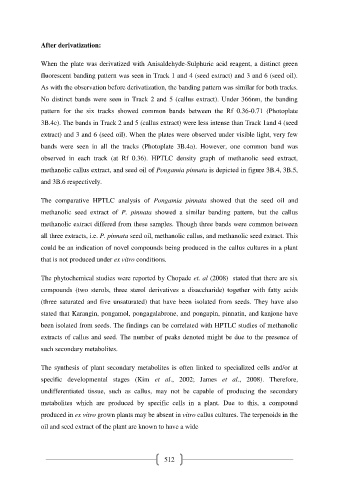Page 522 - e-Book
P. 522
After derivatization:
When the plate was derivatized with Anisaldehyde-Sulphuric acid reagent, a distinct green
fluorescent banding pattern was seen in Track 1 and 4 (seed extract) and 3 and 6 (seed oil).
As with the observation before derivatization, the banding pattern was similar for both tracks.
No distinct bands were seen in Track 2 and 5 (callus extract). Under 366nm, the banding
pattern for the six tracks showed common bands between the Rf 0.36-0.71 (Photoplate
3B.4c). The bands in Track 2 and 5 (callus extract) were less intense than Track 1and 4 (seed
extract) and 3 and 6 (seed oil). When the plates were observed under visible light, very few
bands were seen in all the tracks (Photoplate 3B.4a). However, one common band was
observed in each track (at Rf 0.36). HPTLC density graph of methanolic seed extract,
methanolic callus extract, and seed oil of Pongamia pinnata is depicted in figure 3B.4, 3B.5,
and 3B.6 respectively.
The comparative HPTLC analysis of Pongamia pinnata showed that the seed oil and
methanolic seed extract of P. pinnata showed a similar banding pattern, but the callus
methanolic extract differed from these samples. Though three bands were common between
all three extracts, i.e. P. pinnata seed oil, methanolic callus, and methanolic seed extract. This
could be an indication of novel compounds being produced in the callus cultures in a plant
that is not produced under ex vitro conditions.
The phytochemical studies were reported by Chopade et. al (2008) stated that there are six
compounds (two sterols, three sterol derivatives a disaccharide) together with fatty acids
(three saturated and five unsaturated) that have been isolated from seeds. They have also
stated that Karangin, pongamol, pongagalabrone, and pongapin, pinnatin, and kanjone have
been isolated from seeds. The findings can be correlated with HPTLC studies of methanolic
extracts of callus and seed. The number of peaks denoted might be due to the presence of
such secondary metabolites.
The synthesis of plant secondary metabolites is often linked to specialized cells and/or at
specific developmental stages (Kim et al., 2002; James et al., 2008). Therefore,
undifferentiated tissue, such as callus, may not be capable of producing the secondary
metabolites which are produced by specific cells in a plant. Due to this, a compound
produced in ex vitro grown plants may be absent in vitro callus cultures. The terpenoids in the
oil and seed extract of the plant are known to have a wide
512

